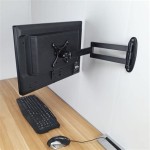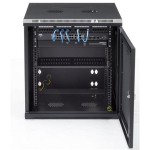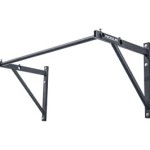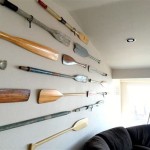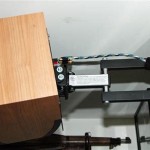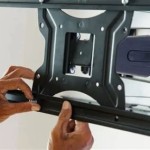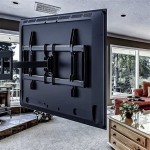Wall Mounted Exhaust Fans for Kitchens: A Comprehensive Guide
Maintaining good air quality in a kitchen is essential for comfort, hygiene, and even safety. Cooking activities release various pollutants, including smoke, grease, odors, and excessive moisture. These byproducts can not only create an unpleasant environment but also contribute to the growth of mold, damage kitchen surfaces, and potentially pose health risks. A wall-mounted exhaust fan is a vital appliance for efficiently removing these contaminants, improving ventilation, and ensuring a healthier and more comfortable kitchen space.
This article provides a comprehensive overview of wall-mounted exhaust fans for kitchens, covering their functionality, benefits, types, selection criteria, installation considerations, and maintenance best practices. It aims to equip readers with the necessary knowledge to make informed decisions about choosing and installing the right exhaust fan for their specific kitchen needs.
Understanding the Functionality of Wall Mounted Exhaust Fans
A wall-mounted exhaust fan operates by drawing air from the kitchen area and expelling it outside the building. This process creates negative air pressure, which then pulls in fresh air from other parts of the house or through open windows. This continuous air exchange helps to remove pollutants generated during cooking, such as smoke, grease particles, cooking odors, and excess humidity.
The essential components of a wall-mounted exhaust fan include a fan motor, fan blades, a housing, a grille, and a duct. The motor powers the fan blades, which create the airflow. The housing encases the motor and blades, providing structural support and protecting the internal components. The grille covers the opening of the fan, preventing large objects from entering and potentially damaging the blades. The duct connects the fan to an exterior vent, allowing the exhaust air to be discharged outside.
The efficiency of an exhaust fan is measured in Cubic Feet per Minute (CFM). CFM indicates the volume of air the fan can move in one minute. A higher CFM rating signifies a more powerful fan capable of removing air more quickly. Determining the appropriate CFM rating for a kitchen is crucial for ensuring adequate ventilation. Factors to consider when calculating the required CFM include the size of the kitchen, the type of cooking typically performed, and the presence of any gas appliances.
Key Benefits of Installing a Wall Mounted Kitchen Exhaust Fan
Installing a wall-mounted exhaust fan in a kitchen offers numerous benefits, enhancing the overall quality of the cooking environment and protecting the home's structure. These benefits can be broadly categorized into air quality improvement, property protection, and energy efficiency.
Air Quality Improvement: The primary benefit of an exhaust fan is the significant improvement in indoor air quality. By effectively removing smoke, grease, and odors, the fan reduces the concentration of airborne pollutants, creating a healthier atmosphere for occupants. This is particularly important for individuals with respiratory conditions, such as asthma or allergies, who may be sensitive to these pollutants. Furthermore, reducing excess moisture helps to prevent the growth of mold and mildew, which can trigger allergic reactions and contribute to respiratory problems.
Property Protection: Grease and moisture produced during cooking can accumulate on kitchen surfaces, including walls, ceilings, and cabinets. Over time, this accumulation can lead to staining, discoloration, and even structural damage. An exhaust fan helps to prevent this buildup by extracting the grease and moisture before they have a chance to settle. Reducing moisture also minimizes the risk of wood rot and corrosion, extending the lifespan of kitchen fixtures and appliances.
Odor Control: Cooking odors can linger in a kitchen and spread throughout the house, creating an unpleasant environment. An exhaust fan efficiently removes these odors before they permeate other areas, maintaining a fresh and clean atmosphere. This is particularly beneficial when cooking strong-smelling foods, such as fish or spices.
Energy Efficiency: While an exhaust fan consumes energy, it can indirectly contribute to energy efficiency by reducing the need for air conditioning. By removing hot air and moisture, the fan reduces the burden on the air conditioning system, allowing it to operate more efficiently and consume less energy. Some exhaust fans also come equipped with energy-efficient motors and features like automatic shut-off timers, further minimizing energy consumption.
Types of Wall Mounted Exhaust Fans and Selection Criteria
Wall-mounted exhaust fans are available in various types, each offering different features, performance characteristics, and aesthetic designs. The selection of the appropriate type depends on factors such as the size of the kitchen, the style of cooking, budget constraints, and personal preferences. Common types include propeller fans, centrifugal fans, and inline fans.
Propeller Fans: Propeller fans are the most common and typically the least expensive type of wall-mounted exhaust fan. They consist of a simple propeller-shaped blade that rotates to move air. Propeller fans are generally suitable for small kitchens or areas where ventilation requirements are minimal. They are relatively easy to install and maintain. However, they tend to be noisier than other types of fans and may not be as effective at removing heavy smoke or grease.
Centrifugal Fans: Centrifugal fans, also known as blower fans, use a squirrel-cage impeller to draw air into the fan and then expel it outwards. This design allows for more efficient air movement and higher static pressure compared to propeller fans. Centrifugal fans are better suited for larger kitchens or kitchens where heavy cooking is frequent. They are typically quieter and more effective at removing smoke and grease than propeller fans. However, they are generally more expensive.
Inline Fans: Inline fans are installed within the ductwork and are designed to provide powerful and quiet ventilation. They are particularly useful for kitchens where the exhaust duct needs to travel a long distance to reach the exterior vent. Inline fans can be located remotely, reducing noise levels in the kitchen. They offer excellent performance and energy efficiency but require more complex installation.
Selection Criteria: Several factors should be considered when selecting a wall-mounted exhaust fan. The most important factor is the CFM rating, which should be appropriate for the size of the kitchen and the type of cooking performed. Noise level, measured in sones, is another important consideration, especially for open-concept kitchens where noise can be disruptive. Features such as variable speed settings, timers, and automatic shut-off can enhance convenience and energy efficiency. The aesthetic design of the fan should also complement the overall kitchen décor. Finally, budget constraints will play a role in determining the type and features of the exhaust fan chosen.
Installation Considerations for Wall Mounted Kitchen Exhaust Fans
Proper installation is crucial for ensuring the optimal performance and longevity of a wall-mounted exhaust fan. While some homeowners may choose to install the fan themselves, professional installation is generally recommended, especially for more complex installations involving ductwork or electrical wiring. Careful planning and adherence to local building codes are essential for a safe and effective installation.
Location: The location of the exhaust fan should be carefully selected to maximize its effectiveness. Ideally, the fan should be positioned directly above the stovetop or cooking area, where it can capture the most smoke, grease, and odors. The fan should also be installed in a location that allows for easy access for cleaning and maintenance. Consideration should be given to existing electrical wiring and the availability of a suitable exterior vent. For optimal performance, the duct run should be as short and straight as possible.
Ductwork: The ductwork connects the exhaust fan to the exterior vent and is responsible for carrying the exhaust air outside. The ductwork should be made of rigid metal, such as galvanized steel or aluminum, to prevent sagging and ensure proper airflow. Flexible ductwork is generally not recommended as it can restrict airflow and accumulate grease. The diameter of the ductwork should match the outlet size of the exhaust fan to avoid reducing its efficiency. The ductwork should be properly insulated to prevent condensation and heat loss.
Electrical Wiring: The exhaust fan requires a dedicated electrical circuit to ensure safe and reliable operation. The electrical wiring should be installed by a qualified electrician and should comply with local electrical codes. The fan should be properly grounded to prevent electrical shock. It is important to disconnect the power supply before performing any electrical work on the fan.
Exterior Vent: The exterior vent is the point where the exhaust air is discharged outside the building. The vent should be located away from windows, doors, and air intakes to prevent the exhaust air from re-entering the building. The vent should be equipped with a backdraft damper to prevent outside air from entering the ductwork when the fan is not in use. The vent should also be protected from the elements to prevent water or snow from entering the ductwork.
Maintenance and Care of Wall Mounted Exhaust Fans
Regular maintenance is essential for maintaining the performance and extending the lifespan of a wall-mounted exhaust fan. Neglecting maintenance can lead to reduced airflow, increased noise levels, and potential fire hazards. The frequency of maintenance will depend on the amount of cooking performed and the type of food prepared.
Cleaning the Grille and Filter: The grille and filter are the primary components that require regular cleaning. The grille should be cleaned regularly to remove accumulated grease and dust. The filter should be cleaned or replaced regularly, depending on the type of filter. Grease filters are typically washable and can be cleaned in a dishwasher or with a degreasing solution. Charcoal filters, which are used to absorb odors, are typically disposable and should be replaced according to the manufacturer's instructions. A clogged filter can significantly reduce the fan's airflow and increase its energy consumption.
Cleaning the Fan Blades: The fan blades should be cleaned periodically to remove any accumulated grease or dust. Disconnect the power supply before cleaning the fan blades. Use a soft cloth or brush to remove the debris. Avoid using harsh chemicals or abrasive cleaners, which can damage the fan blades. Ensure the fan blades are completely dry before reconnecting the power supply.
Checking the Ductwork: The ductwork should be inspected periodically for any signs of damage, such as leaks or blockages. Loose connections should be tightened. If the ductwork is visibly dirty, it should be cleaned by a professional duct cleaning service. A blocked or damaged duct can significantly reduce the fan's efficiency and potentially create a fire hazard.
Lubricating the Motor: Some exhaust fans require periodic lubrication of the motor. Refer to the manufacturer's instructions for specific recommendations. Use a lightweight oil or grease that is specifically designed for electric motors. Avoid over-lubricating the motor, as this can attract dust and debris.
By following these maintenance guidelines, homeowners can ensure that their wall-mounted exhaust fan continues to provide effective ventilation and a healthy kitchen environment for years to come.

Kdk Wall Mount Kitchen Ventilating Fan 25aufa
Bsboss Brand Ready Stock Pvc Wall Type Exhaust Fan Kitchen Ventilation 6inch 8inch 10inch 12inch

6 8 10 12 Inch Kitchen Garage Wall Exhaust Ventilation Fans Futina

220v Light Weight Ac Warehouse Kitchen Metal Wall Mounted Electric Exhaust Fan

Stainless Steel Exhaust Fan Wall Mounted Ventilation For Kitchen Bathroom
2024new Al House Punch Free Wall Mounted Fan Kitchen And Toilet High Power Rechargeable Student Dormitory Exhaust

6 8 10 12 Inch Kitchen Garage Wall Exhaust Ventilation Fans Futina

Exhaust Fan 12 Inch 35cm Hole Louver Kitchen Bathroom Toilet Wall Mount Ventilator Sg

Stainless Steel Exhaust Fan Wall Mounted Ventilation For Kitchen Bathroom

Kdk Ventilating Fans Residential Use Wall Mount Propeller

